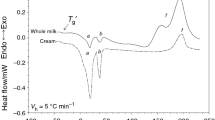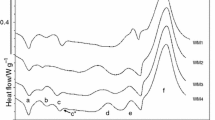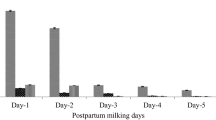Abstract
Milk components are assumed to be uniformly distributed in a concentrate whilst it is being dried. During milk powder production, these components are redistributed in the drying droplets and the powder surface composition is significantly different from that of the bulk of it. The objective of this article was to analyze and compare phase transitions of powdered baby formulas as well as to make a study of their FT-IR spectra. Food powders of different composition were tested by a differential scanning calorimeter (DSC, TA Instruments Q 200) with a normal pressure cell and a System 2000 spectrophotometer. Significant differences were observed in the shape of curves of the mixtures and the agglomerates. The observed phase transitions in powders depended on fat content. Characteristic peaks of melting lactose were observed in the curves of the powdered baby formulas. The IR spectra proved to be useful in determining adulteration of baby formulas. Both methods were complimentary during a thorough evaluation of these food powders.





Similar content being viewed by others
References
Chang K, Kim D, Kim S. The effect of water activity on the flow properties of simulated food powders. Engineering & Food at ICEF 7. 1997; Part 2 A, pp 228–231.
Teunou E, Fitzpatrick J, Synnott E. Characterization of food powder flowability. J Food Eng. 1999;39:31–7.
Ostrowska-Ligęza E, Lenart A. Effect of water activity on mechanical properties of cacao powders. Materials from XI Seminar Properties of Water in Foods, Kudowa Zdrój; 2000. pp 60–72.
Peleg M, Scoville E. Evaluation of the effects of liquid bridges on the bulk properties of model powders. J Food Sci. 1981;46:174–7.
Kim E, Chen X, Pearce D. Surface composition of industrial spray-dried milk powders. Development of surface composition during manufacture. J Food Eng. 2009;94:163–8.
Chan H, Chew N. Novel alternative methods for the delivery of drugs for the treatment of asthma. Adv Drug Deliv Rev. 2003;55(7):793–805.
Chiou D, Langrish T, Braham R. The effect of temperature on the crystallinity of lactose powders produced by spry drying. J Food Eng. 2008;86:288–93.
Fitzpatrick J, Hodnett M, Towmey M, Cerqueira P, O’Flynn J, Roos Y. Glass transition and the flowability and caking of powders containing amorphous lactose. Powder Technol. 2007;178:119–28.
Chiavaro E, Cerretani L, Paciulli M, Vecchio S. Kinetic evaluation of non-isothermal crystallization of oxidized extra virgin olive oil. J Therm Anal Calorim. doi:10.1007/s10973-011-2083-7.
Roos Y. Thermal analysis, state transitions and food quality. J Therm Anal Calorim. 2003;71:197–203.
Vivoda M, Roškar R, Kmetec V. The development of a quick method for amorphicity determination by isothermal microcalorimetry. J Therm Anal Calorim. 2011;105:1023–30.
Kowalska J, Lenart A. The influence of ingredients distribution on properties of agglomerated cocoa products. J Food Eng. 2005;68:155–61.
**apong N, Suphantharika M, Jamnong P. Production of instant soymilk powders by ultrafiltration, spray drying and fluidized bed agglomeration. J Food Eng. 2008;84:194–205.
Jakubczyk E, Ostrowska-Ligęza E, Gondek E. Moisture sorption characteristic and glass transition temperature of apple pure powder. Int J Food Sci Technol. 2010;45:2515–23.
Ostrowska-Ligęza E, Szulc K, Lenart A. Phase transitions of ingredients of the powdered baby formulas. Zesz Prob Post Nauk Rol. 2010;553:171–82. (in Polish).
Borawska M, Koczoń P, Piekut J, Świsłocka R, Lewandowski W. Vibrational spectra and antimicrobial activity of selected bivalent cation benzoates. J Mol Struct. 2009;919:284–9.
Zhang H, Takenada M, Isobe S. DSC and electrophoretic studies on soymilk protein in denaturation. J Therm Anal Calorim. 2004;75:719–26.
Gombas A, Szabo-Revesz P, Kata M, Regdon G Jr, Erös I. Quantitative determination of crystallinity of α-lactose monohydrate by DSC. J Therm Anal Calorim. 2002;68:503–10.
Ostrowska-Ligęza E, Wirkowska M, Kowalski B. Thermokinetic analyses of corn grain fat by differential scanning calorimetry. Food Sci Technol Qual. 2009;1(62):128–39. (in Polish).
Fierz H. Use of calorimetry to evaluate safety of processing. In: Kaletunc G, editor. Calorimetry in food processing. Oxford: IFT Press, Wiley-Blackwell; 2009. p. 351–67.
Szepes A, Fiebig A, Ulrich J, Szabo-Revesz P. Structural study of α-lactose monohydrate subjected to microwave irradiation. J Therm Anal Calorim. 2007;89(3):560–75.
Lopez C, Ollivon M. Crystallisation of triacylglycerols in nanoparticles. Effect of dispersion and polar lipids. J Therm Anal Calorim. 2009;98:29–37.
Spigno G, Pagella C, Faveri D. DSC characterization of cocoa butter polymorphs. Ital J Food Sci. 2001;13:275–84.
Cebula D, Smith K. Differential scanning calorimetry of confectionery fats. Pure triglycerides: effects of cooling and heating variation. J Am Oil Chem Soc. 1991;68:591–5.
Raemy A, Nouzille C, Lambelet P, Marabi A. Overview of calorimetry as a tool for efficient and safe food-processing design. In: Kaletunc G, editor. Calorimetry in food processing. Oxford: IFT Press, Wiley-Blackwell; 2009. p. 202–36.
Acknowledgements
This study was supported by the Ministry of Science and Higher Education grant No. N N312 366637.
Author information
Authors and Affiliations
Corresponding author
Rights and permissions
About this article
Cite this article
Ostrowska-Ligęza, E., Górska, A., Wirkowska, M. et al. An assessment of various powdered baby formulas by conventional methods (DSC) or FT-IR spectroscopy. J Therm Anal Calorim 110, 465–471 (2012). https://doi.org/10.1007/s10973-011-2158-5
Published:
Issue Date:
DOI: https://doi.org/10.1007/s10973-011-2158-5




